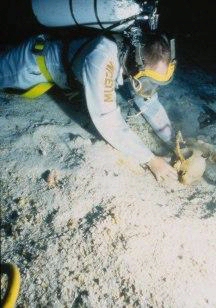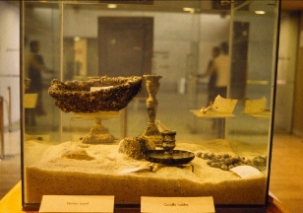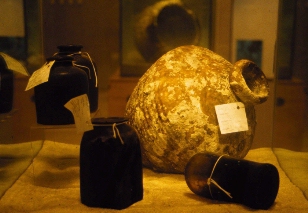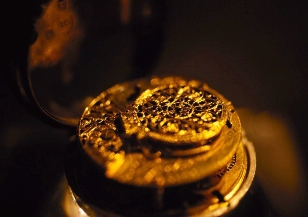
Figure 8: Queensland Museum divers recovering artefacts from the wreck site.
Image used courtesy of the Queensland Museum
What remains of the Pandora has often been described as one of the best-preserved and significant shipwreck sites in Australia and, indeed, the Southern Hemisphere. It has been the source of much interest ranging from media coverage, both scientific and popular publications, public displays and archaeological research.

Figure 8: Queensland Museum divers recovering artefacts from the wreck site.
Image used courtesy of the Queensland Museum
In April 1979, two years after its rediscovery, an archaeological assessment survey of the wreck site was launched to assist in the long term management of Pandora as a heritage resource. It was performed on behalf of the Australian Government's Department of Home Affairs, and was led by Graeme Henderson, a maritime archaeologist from the Western Australian Museum. The aims of the survey were to establish if the wreck was in fact the Pandora, to further assess the site's archaeological significance, and to investigate the feasibility of future excavation and removal of artefacts for research and public display (Henderson 1979).
During that expedition, Henderson found markers that indicated the wreck was of late 18th century British Royal Navy origin, and the site was consequently confirmed as being the Pandora. In terms of the international classification system for grading wreck sites as to levels of importance, the wreck was labelled as 'first class', indicating that the site has extensive structural remains and a highly coherent artefact distribution (Muckelroy 1978, 162-65). In his report, pertaining to the superb condition of the site, Henderson (1979) wrote:
"The observed distribution of material exposed on the seabed indicates that the vessel was subjected to very little disturbance after settling on the bottom. Judging from the superficial layer inspection of the wreck, and the site conditions - deep water, level sand, no rock and no turbulence - the Pandora may prove to be one of the best preserved in Australian waters. Certainly the conditions for preservation are superior to those on any other known pre-1800 wrecks in Australian waters."
This high level of preservation is responsible for the survival of human skeletal remains in such excellent condition, after more than 200 hundred years of salt-water immersion.
Shortly after Henderson's' initial report, the Pandora was officially listed under the Historic Shipwrecks Act (1976), which provides protection to wrecks or shipwreck relics which are considered to have historical importance, and aims to provide long-term conservation of significant wrecks which represent maritime heritage (Gesner 1991).
On the final pages of his report, Henderson wrote that it was 'unlikely' that any of the crew would have been trapped below when the ship went down. Such a statement was, at the time, well justified. Human remains were not expected to be recovered from the wreck. However, the fact that they were discovered subsquently simply adds to the significance and historical importance of the wreck. The presence of human remains has been described as the 'most emotive discovery of all' (Coleman 1989, 123).
Following the 1979 preliminary report of the site, it was recommended that a full archaeological excavation be carried out. Additionally, because of the tremendous potential of the wreck, a protective zone with a radius of 500m was established around the site in 198 1 under the authority of the Act.


Figure 9 and 10: Artefacts recovered from the wreck
The wreck provides the largest collection of contemporary material remains of the Bounty saga, and is the only cohesive wreck representative of the great age of Pacific discovery and exploration (with the exception of the Laperouse wrecks). The Pandora's contents are of extreme importance to many scholars, including Royal Naval historians, archaeologists, technology historians, social historians or ethnologists. The research carried out by the present authors focuses on just one aspect of the Pandora saga: the analysis of the human skeletal remains which have been recovered from the site.
 >
>
Figure 11: Surgeon Hamilton's fob watch
© Internet Archaeology
URL: http://intarch.ac.uk/journal/issue11/4/11.html
Last updated: Thu Mar 28 2002